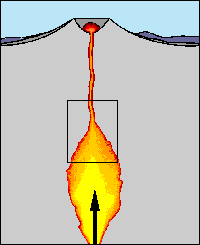How is a volcano formed?
By starsun
@starsun (316)
India
December 12, 2006 8:35pm CST
o examine a volcano, one must first examine the makeup of the earth itself. The earth is made up of several layers. The thin, outermost layer is called the crust. This is the area that we walk on. The innermost piece of the earth is called the core, and it contains boiling gases, magma and iron. The middle of the earth, in between the outer and inner parts, is called the mantle. This part of the earth contains mostly rock.
Volcanoes are, literally, mountains with holes in their tops. When rock melts in the mantle of the earth, it rises toward the surface for release. It collects in a reservoir called a magma chamber, usually under a volcano. When this rock reaches the surface and erupts from the earth, along with pent-up gases, this is an eruption. The surface and slope of the volcano will swell with gas and lava before this event. The fountain of liquid rock that comes from an eruption will form a "spatter cone" around the areas that the earth is releasing lava from. This cone will direct molten lava away from the cone and down the volcano.
There are four kinds of volcanoes that have been discovered on earth and in our solar system:The shield volcano: This volcano is formed from fluid basaltic magma. The explosions made by this volcano are generally less violent than those of other volcanoes. These volcanoes are generally also smaller and flatter than other volcanoes.
The cinder cone: These volcanoes are fomed by basaltic and andesitic magma, and they are named cinder cones because they blow ash into the sky. Eruptions from these volcanoes tend to contain a lot of gas.
The dome: This is a shorter, rounder volcano formed by viscous dacite magma. This volcano has smaller eruptions but more lava flow than the typical volcano.
The stratovolcano: This volcano is the most dangerous kind, due to its huge size and height. Formed by andesite and dacite lava, this volcano tends to be extremely dangerous. Firestorms, mud flows and pyroclastic flows are all caused by this type of volcano.
The caldera: This is a generally dry, extinct volcano formed near or in water.
When the earth was very young, it was covered with volcanoes, because the inner layers of the earth were still shifting and taking form. Volcanoes are very common on other planets, and several have even been spotted by advanced scientific equipment. Volcanoes create islands and archipelagos. Without volcanoes, we would not have Hawaii! Therefore, while they are violent, volcanoes play a large part in the formation of the earth.
Volcanoes are often so long extinct that it is possible for people to study them intensively, and even live inside them their whole lives. In California, New Mexico, and even Yellowstone National Park, people are living inside volcanoes. This should give one an idea of the fickle nature of the volcanic explosion.
While volcanoes have not been considered dangerous in the past, more and more people are beginning to realize that they may actually pose a threat in certain areas. In the United States, several projections indicate that Mt. Ranier, an inactive volcano, may become active again. Other places in the world are living in the shadow of an imminent explosion. Scientists are working on obtaining the equipment to spot an impending eruption before it causes harm. It is possible to measure the slope and the gas gradation of the air near a volcano to test for impending eruption. Advances in this area may allow scientists to spot the day an eruption will occur.
Volcanoes can cause more harm than simply a lava flow. While lava is deadly to a person, volcanoes can also cause mudslides and rockslides, killing many. A volcano's explosion can send debris raining down on up to twenty miles around itself. Often, volcanoes can cover areas with thick ash, which, added to damage from lava flows, destroys houses, towns and crops.
The entire ecosystem of an area can be altered by a single volcano eruption. Certain types of "fireflows" can also result from a volcano. "Pyroclastic" flows, or mixtures of burning gases, can wipe out entire areas in a few minutes, moving in the same direction as a lava flow. The impact from an eruption can jar the surface of the earth itself, especially if the eruption occurs along the edge of a tectonic plate. If disturbances still exist underground, they can cause anything from large earthquakes to storms and killer waves.
In some cases, eruptions have been known to be good. In areas with imbalanced ecosystems, volcanoes help restore balance because of the "cleansing" that they bring. Like a forest fire, the volcano destroys an unhealthy ecosystem and gives it the chance to start anew.
In conclusion, there are many different kinds of volcanoes. Through these holes in the earth, we can get a better glimpse of what is going on beneath our feet. While volcanoes are less active now than they were at the earth's formation, they can still pose a threat to humans. With new research and geological equipment, however, perhaps we will soon be able to harness the power of the volcano and use our knowledge to keep ourselves, and thriving ecosystems, safe.
No responses





